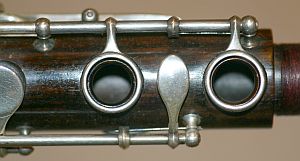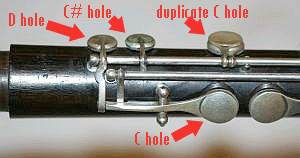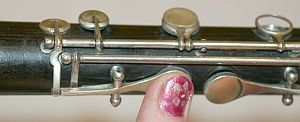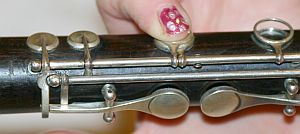

Richard Carte (1808–1891) is an important figure in the flute world. He was an English flutist and an early player (1843) of Boehm's conical flute of 1832. Carte admired the open-key system and the tone of Boehm's flute, but believed that the old fingering offered superior facility of execution. He solution was a very clever design that became known as the Carte 1851 System flute. He explained his motivation in 1851; we append what was reprinted in Rockstro (1889) at the end of this section.
Carte joined the firm of Rudall & Rose in 1850, and together they manufactured Carte's instrument. Rudall & Rose were already making conical and cylindrical Boehm flutes, and the Carte 1851 flute had more-or-less the same size holes and bore. So it would sound similar to, if not the same as, a Rudall & Rose—or a Rudall, Rose & Carte—Boehm flute. It was the mechanism and fingering that were different.
Many Carte 1851 flutes are metal. Below are shown two such instruments. We are indebted to Robert Bigio for providing these photographs, as well as for helpful electronic conversations. The second instrument is a "Rockstro's Model" 1851 flute, with extra large holes.


Some (few) Carte 1851 flutes are conical. The one below is stamped Rudall & Rose (still no Carte in the firm's name), "Carte's Patent / 33".

A similar instrument, number 31, is in the Edinburgh University Collection; see the very end of that page. The original footjoint of number 33 is lost; the one shown above is from the Clinton Equisonant flute mentioned elsewhere on this site.

Carte's flute has 14 large holes and two smaller ones at the top, from which c''# and d'' sound. There is a duplicate F hole covered by a closed-standing key (operated by a short F key), but all other holes except the low D# hole are covered by open-standing keys or ring keys. The photo below shows the large holes (for RH2 and RH3) and the short F key.

The 1851 flute is fully vented: when a note in the first two octaves is played with the normal fingering, all holes below the sounding hole are open. The slight veiling of the F# (or the one-and-one Bb) on the Boehm flute is not present on the F# or any other note when the normal fingering is used.
Carte has restored the F# fingering of the old flute; the first finger of the right hand gives F#, not F natural. There were three fingerings for F natural. These are described in the section on the Radcliff model flute, so we omit further discussion here except to mention that only the forked F is veiled. Carte retained the open G# key of Boehm. The left hand thumb operates the B key and the Bb key (below the B key) on the underside of the flute.
A novel feature of the 1851 flute, one that would also appear on the Carte 1867 model flute, is the "open D". When all holes are open (all fingers off save possibly RH4), d'' sounds rather than c''# (or d''' rather than c'''#, when overblown). To get c''#, one must keep the thumb on the B key below the flute, which is not so hard. The open d'' should not be used all the time, because its tone hole is small, like that for c''#. But a player who can manage the c''# on a Boehm flute will have no difficulty getting a good tone with the open D on the 1851 flute. (On Carte's original models, the ordinary d'' fingering was not available, but this was changed by the end of 1851, according to Rockstro.) The open D makes numerous passages (e.g. fast passage work with high note d'') and ornaments (e.g. a turn on c''#) a lot easier. The fingerings for d'', c''#, and c'' are shown below.



The open D doesn't affect the rest of the fingering (except for some trills), because the little D hole is closed by LH3 and RH1 as well as the thumb. Any of those fingers can be used for the D/C# trill. The Db/C trill is done with LH1 while LH3 is down.
It is perhaps unfortunate that the Carte flute returns to the awkward technique of the short F and (the modified form of) the long F key, unless one is willing to use the veiled forked F. This would be fixed with the Carte 1867 system flute!
The mechanisms of the Carte 1851 and 1867 system flutes are relatively complex, and so are more difficult to keep well adjusted than that of the Boehm flute. The key for RH1 is the extreme in that when it is depressed, four key pads (over the holes for G, G#, C thumb, and the little hole for d'') are caused to descend, and they must seal the holes simultaneously and completely.
Carte argues that his system eases the work of the left hand thumb and little finger in his remarks below. (On an open G# flute, LH4 is inactive even in easy keys.) He doesn't say how in the excerpt, but I will tell you: it is because he has ensured that the key for RH1 closes both the G# hole and the C hole (as well as the D and G hole) and so the thumb and little finger can just relax sometimes while their duties are carried out automatically. For example, when fingering G# with LH1,2,3 (remember the open G#, so LH4 is not used), lowering RH1 gives F#. LH4 is never called into play. The G#/F# trill is easy.
Having myself taken up the Boehm flute warmly, upon its first introduction into this country, and having been the first native professor to perform upon it in public, I watched with interest the experiments of the many talented individuals occupied in endeavouring to carry out its principles in the new direction, intending, if one should be produced with the same perfection of tone and tune, but with greater facility of execution, to adopt it. It was not until all these efforts had failed, that, for the first time, I gave my attention fully to the subject, with the view of ascertaining whether I could not design a mechanism which should retain the open keys and equidistant holes of Boehm's flute, and yet secure a greater facility of fingering. I was the more readily emboldened to make this attempt, as I had full knowledge of the means taken by all those who had preceded me, and of the nature and cause of the failure of their endeavours. In a short time I succeeded beyond what I could possibly have anticipated. The great cause of difficulty in fingering the Boehm flute arises from the necessity of constantly keeping the little finger and thumb of the left hand upon their keys to shut them. .... This, especially in the upper octave, cramps the action of the other fingers. The cause of the superior facility of the ordinary flute is the freedom of these fingers, the keys worked by them being kept closed by their springs. As the open keys were the cause of the superior tone of Boehm's flute, and the closed keys the cause of the superior facility of execution of the old flute, the object was to free the little finger and thumb, and yet retain the open keys, so that facility of execution and beauty of tone might be at once secured. This I have been enabled to effect By means of the mechanism adopted, every perfect note of Boehm's is retained, and some additional fine ones are gained; and at the same time a facility of execution is secured never dreamed of even by players on the old flute. ..."
By the introduction of an additional hole for the note D of the second and third octaves, some further most objectionable cross-fingerings of both the Boehm and the Ordinary flutes are also removed, and the necessity of boring the C sharp hole, so as to adapt it, though imperfectly, for several different purposes is no longer necessary, and this note is rendered as perfect for its legitimate use (C sharp) as any other note, which is not the case upon either of the other flutes.
